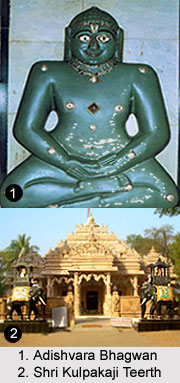 Shri Kulpakaji Teerth located in Andhra Pradesh is a Jain pilgrimage centre. The teerth kshetra is on the outskirts of the Kulpaka village. The temple is dedicated to Shri Adishvara Bhagwan.
Shri Kulpakaji Teerth located in Andhra Pradesh is a Jain pilgrimage centre. The teerth kshetra is on the outskirts of the Kulpaka village. The temple is dedicated to Shri Adishvara Bhagwan.
History of Shri Kulpakaji Teerth
According to history Shri Kulpakaji Teerth dates back to the ancient times. The idol of Shri Adishvara Prabhu is known after the name Shri Manikyaswami. As per reference Bharata Chakravati had established twenty four of divinities on the Ashtapada Mountain. It is believed that the idol of Shri Adishvara Bhagwan is one of those twenty four divinities. It was carved from the sapphire in his ring. The teerth kshetra is associated with many legends and miracles. It is believed that king Ravana with the help of his divine propitiation acquired the idol of Shri Adishvara Prabhu. Another legend suggests that Shri Shankara Raja had acquired this idol in 680 of the Vikram Samvat Era when he was praying to the goddess. He then built this temple and installed the idol on it. Since the construction of the temple the temple has been repaired and renovated in V.S. 1481 and 1767. Devotees from different places visit the temple to offer their prayers. It is said that the lord fulfils all the desires of the pilgrims if prayed with full devotion.
Temple of Shri Kulpakaji Teerth
The temple of Shri Kulpakaji Teerth is houses the idol of Shri Adishvara Bhagavan. The temple is very old and stands as a unique example of ancient art and architecture. It is a magnificent temple decorated and embellished with ancient architectural designs. The artistic designs of the temple boast about the skills of the craftsmen. The idol is black in colour and is seated in semi-padmasana posture. It is 32 1/2 inches in width and 37 1/2 inches in height. It looks very attractive and appealing to the eyes. No mark of mane can be seen at the back of the idol but behind the head there is a circle of lustre. Apart from this there are many other idols installed in the temple. An idol is established on the right hand side of the main idol. It is made of black stone. Similarly on the left side there is another idol made of white marble. Other than these there are 15 other idols here. Each idol has been tastefully decorated and looks splendid. A stone-inscription of V.S. 1333 is also available here. It provides information about the teerth kshetra as well as the main idol.
The Temple of Shri Kulpakaji Teerth organises many annual gatherings and functions. Every year a function is organised on the purnima day in the month of Chaitra. It is attended by many pilgrims from different places. There are provisions for dharamshalas or rest houses for the pilgrims. These are well equipped with all modern facilities. The temple is surrounded by scenic beauty that attracts and mesmerises the pilgrims. The calm and tranquil environment makes it a suitable place for religious activities. The kshetra is well connected to road, rail and air. Taxi services and bus services are easily available here. The nearest bus stop is located at Aler at a distance of 6 kms. The nearest railway is the Alera Railway Station on the Vijayawada-Hyderabad line. The closest airport located here is Hyderabad.




















